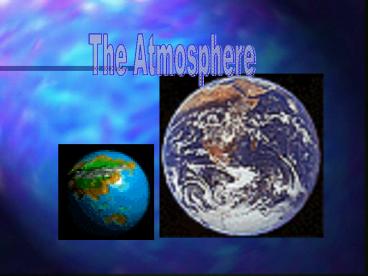The Atmosphere - PowerPoint PPT Presentation
1 / 13
Title:
The Atmosphere
Description:
It also regulates the global temperature and filters out ... The Sunburn Problem. Increasing frequency/ 1014 Hz. Increased risk of skin cancer. uv region ... – PowerPoint PPT presentation
Number of Views:70
Avg rating:3.0/5.0
Title: The Atmosphere
1
The Atmosphere
2
This fragile, nearly transparent envelope of
gases supplies the air that we breathe each day.
It also regulates the global temperature and
filters out dangerous levels of solar radiation.
In recent years, scientific research has shown
that the chemical composition of the atmosphere
is changing because of both natural and human
induced causes. There is growing concern over the
impact of human activities. Mankind may be
increasing levels of heat absorbing gases,
thereby contributing to global warming and
destroying ozone, the fragile atmospheric
ingredient that shields the planet from
ultraviolet (UV) radiation.
3
(No Transcript)
4
I.e Argon has a concentration of 1000 ppm
5
367 is to 0.0367
6
(No Transcript)
7
Light is a stream of tiny packets of energy
called photons
The energy of a photon is equal to the frequency
of light on the wave model multiplied by my
constant h
Albert Einstein
Max Planck
Emc2 , Ehv
Planck constant h 6.63 X 10-34 J/Hz
8
A radio station in the UK transmits at a
frequency of 1.089 x 106 Hz. What is the energy
of a photon of the transmission waves?
Using the equation Ehv
E 6.63 X 10-34 X1.089 x 106 E 7.22 x 10-28 J
Planck constant h 6.63 X 10-34 J/Hz
9
The Sunburn Problem
Increasing frequency/ 1014 Hz
uv region
Causes temporary reddening
Increased risk of skin cancer
10
Molecule absorbs photon, energy excites the
molecule
When an electromagnetic wave hits the atoms of a
material, the energy of that wave is absorbed.
11
- The absorbtion of energy causes the electrons
within the atoms to undergo vibrations. - After a short period of vibrational motion, the
vibrating electrons create a new electromagnetic
wave with the same frequency as the first
electromagnetic wave. - While these vibrations occur for only a very
short time, they delay the motion of the wave
through the medium. Once the energy of the
electromagnetic wave is re-emitted by an atom, it
travels through a small region of space between
atoms. - Once it reaches the next atom, the
electromagnetic wave is absorbed, transformed
into electron vibrations and then re-emitted as
an electromagnetic wave
12
B
1 ½ OO(g) O3
C
A
3O(g)
B C A BA-C B (1 ½ x 498.3) (2 x 302) Hf
O3 143.45 kJ/mol
13
O3
Energy
143.4 kJ/mol
OO































